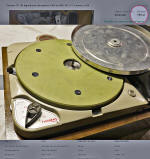-edible zone-
*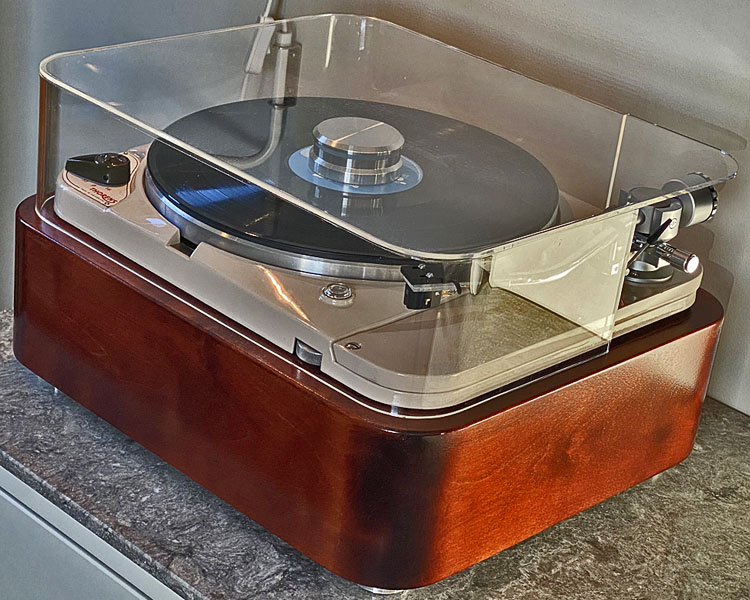
*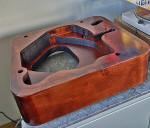
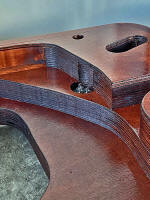 (hint: click thumbnail for full size image)
(hint: click thumbnail for full size image)
*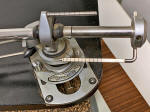 The SME 3012 that came with the sale...
The SME 3012 that came with the sale...
*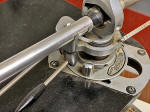 In need of some parts and a little care.
In need of some parts and a little care.
* Peter's comments: - Here are a few pictures of my restored TD124 -
serial 20250. It is my first project and was a real mess when I bought
it. Cleaned, Lubricated and adjusted to my best ability. New main
bearing and polished motor- and stepped pulleys. Idler wheel from
Audiosilente, Motor conversion kit from Hanze. Tonearm ABIS TA-1 fitted
with a Hana SL. Chassis and armboard have been repainted. The plinth is
massive high quality Birch plywood framed with solid Birch. It's built
to my specs by a carpenter (guitar builder). And the feet? Well - very
cheep Chinese stuff : D"
Over the last couple of years a range
of different turntables have passed through my living room. TD318,
TD165, TD125, Lenco L75 and a VPI Scout. Of those it was the Lenco that
inspired me to my first project. It was stripped, and repainted. I made
a big plinth in plywood which I veneered with walnut. An SME3012 in
great condition was mounted and it played really well with its SPU pick
up. However I was not entirely happy with the finish. Even if the casual
observer couldn’t see it, the blemishes screamed in my eyes. So when I
stumbled on a NOS Thorens TD 320 mk2, I had to buy yet another TT. I
mean, how often do you get to un-box a brand new TT from the late
80/early 90-ties? Still beautiful, the brand new TD320 didn’t fulfill my
needs for that vintage look or my need to fiddle around with the TT
occasionally. So, in March 2020, a really worn TD124 mk1 with a SME 3012
was bought on a local auction site. Obviously in desperate need for
restoration it still attracted quite some attention and before the dust
settled 155 bids where made. I don’t remember the number of bidders but
obviously I was the most stubborn. When it finally arrived at my home it
was in a beaten up cardboard box. The seller had packed it fairly well
with bubble wrap in different sizes (obviously used before), old pieces
of wrinkled newspaper pieces, a sweater and a pair of ladies nylon
stockings...... Imagine!
The serial of the unit is 20250. Its E50
motor has no oiling hole in its lover cover. The stepped pulley rides on
top of a pin together with a ball bearing. I think this was changed
later in the production of the MK1.
Both the TT and the arm were
very dirty. The TT had all the parts needed to run, but the SME 3012
was, among other things, missing its bigger rear weight. Both were very
dirty. Switches on TD124 were stiff from old hardened grease. After an
initial cleaning, to get the parts moving at all, the TT was up and
running. Although running very slow I judged it to be possible to
restore. I dismantled everything, cleaned the parts up and changed
bushings and felt rings in the E50 motor. Some other new parts was
installed:
- Resistor for neon lamp (not sure I actually had to change that, better safe than sorry)
- Strobe mirror (old one degenerated)
- Height adjusting wheels (just for a cleaner nicer look)
- Mushrooms with grommets (unnecessary in high mass plinth)
- Spirit level (was not as nice as the old one - would rather try to refill the dry original)
- Tone armboard screws (for looks)
- Audio silente idler wheel (big improvement)
- MK2 motor upgrade with Hanze springs (big improvement)
- Swissonor main bearing (More silent, no apparent effect on wow/flutter)
Motor pulley and stepped pulley showed some marks. First I thought it
was dirt but cleaning with Isopropyl-alcohol didn’t remove everything.
Mounting the pulleys in the bench drilling machine gently polishing the
surfaces almost removed the oxidation marks. The chassis was masked and
matted with 1200 grit paper. After that the chassis was, together with
the tone arm board, sprayed (first by me, then by a professional) with a
color similar to the original. Restoring the SME is a project on its
own, so a brand new ABIS TA-1 tone arm was ordered from Stefan at
Akkelis Audio, The arm was intended for one of Akkelis' own TD124
projects and was chosen by them, and then by me, because of the
combination of looks, price and performance. The Hana SL was moved from
my previous TT to the TD124.
Listening to the assembled TT was a
very rewarding experience. Its something special to hear a TT that you
have rebuilt yourself finally come to life! But some work still
remained. The doctors stethoscope revealed some noise from the main
bearing and the tonearm could not be lowered enough in its base. After
installing a Swissonor bearing it went silent. If one now leans forward
over the TT and listens carefully, one might -just might- hear something
from the pulley-stepped pulley-idler chain. Finally a friend
machine-turned the base of the tonearm so the arm could be lowered a
couple of millimeters. Another thing needing attention was the main
platter. For some reason it was ever so slightly tilted on the main
bearing. I had a mechanical workshop measure it and they did some
shimming on the interface between the platter and the bearing. That
improved the wow & flutter measurements.
I must confess that I
did not play the TT very much in its original plinth. I had already been
seduced by all the pictures of TD124's in big massive plinths and
decided to go that route. My cousin, a skilled carpenter who builds
acoustic guitars, was trusted to do the woodwork. I downloaded some
drawings to which we did some slight modifications. Material was decided
to a core of Birch plywood of furniture quality glued inside a frame of
solid Nordic birch. It ended up 115 mm high and with a weight of 7kg. A
double sided IEC-contact was mounted in the plinth to allow for easy
disconnection of TT from plinth and the whole player from the mains
outlet. The plinth was stained to match the wooden cabinet of the
amplifier. We also chose not to varnish the plinth, instead keeping some
of the liveliness and structure of the birch.
So what remains to
do? I will try another E50 motor to see if that improves startup time
and the wow & flutter measurements further. I will also try some
decoupling feet. But most important - I will play a lot of music on it!
Peter Lundberg
Sweden
